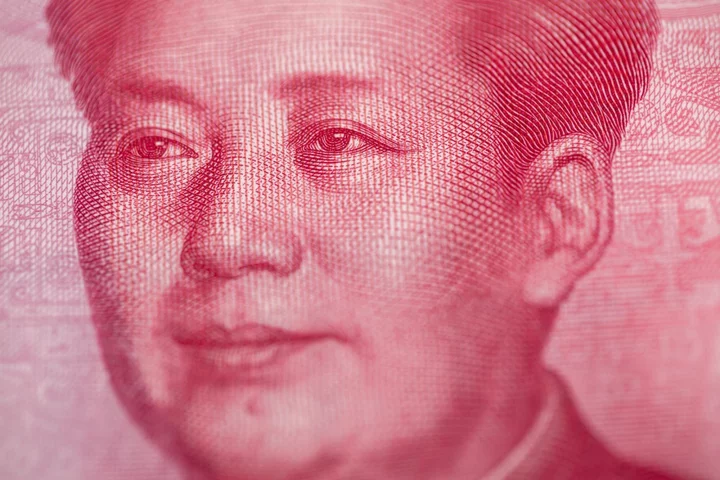The yuan slid past the key 7 per dollar level in offshore trading for the first time since December as disappointing Chinese economic data this week prompted calls for more policy easing.
The onshore currency also neared that threshold after factory output, retail sales and fixed-asset investment all grew at a slower pace in April than economists forecast. At the same time, the yuan tends to be weak in the second quarter due to dividend outflows and rising outbound tourism.
About six months after China abruptly ended its Covid curbs, optimism over the rebound in the nation’s economy that had buoyed yuan assets is now running into a reality check. The Chinese currency has fallen more than 4% since hitting a peak in January, as traders lose patience with lackluster economic data and bet Beijing will eventually add monetary stimulus to support the recovery.
But so far, the People’s Bank of China has been staying on the sidelines — both in the foreign-exchange market and with its liquidity operations. On Wednesday, it refrained from helping sentiment by issuing a stronger reference rate for the yuan, and it also avoided cutting the interest rate on its policy loans earlier this week.
“With no signs that the PBOC is making any attempt to push against yuan weakness for now — this has emboldened the bears,” said Khoon Goh, head of Asia research at Australia & New Zealand Banking Group Ltd. in Singapore. But “don’t forget, the PBOC has a lot of tools they can employ, and market participants will likely be cautious trying to push yuan weakness too far,” he said.
The offshore yuan slipped as much as 0.2% Wednesday to 7.0101 per dollar, extending this year’s decline to 1.2%. The onshore currency depreciated 0.2% to 6.9950.
The PBOC set the currency’s fixing, which limits the onshore yuan’s moves by 2% on either side, at 6.9748, broadly in line with the forecast in a Bloomberg survey of analysts and traders. Bloomberg’s guage of the greenback climbed 0.2% Tuesday as improving US data pushed up Treasury yields.
Hesitant Exporters
China’s still massive trade surplus is failing to translate into yuan strength, with the nation’s relatively unattractive yields compared with those in the US blocking the transmission of export receipts into currency conversion. Exporters also appear hesitant in sell their dollars on concern the yuan may keep falling.
Some exporters have been selling short-dated yuan put options as a way to lock in a better price, according to traders who asked not to be named as they are not authorized to speak publicly.
PBOC Governor Yi Gang said in a March the level of 7 per dollar was no longer a psychological hurdle for the yuan, as the exchange-rate mechanism has been increasingly flexible and increased volatility hasn’t been a problem for businesses or households. China has largely ended currency intervention, he said in April.
The PBOC has plenty of ways to curb yuan weakness whenever it grows uncomfortable. The central bank usually uses the fixing to guide expectations, it used to jawbone the currency and it may become more aggressive by increasing the cost for traders to short the yuan.
Right now, there are as yet few signs of discontent over the yuan’s weakness, according to Nomura Holdings Inc.
“The PBOC’s level of concern may not be 7.0, but instead more towards 7.30,” and the likelihood of intervention is low in the near term, strategists at the bank led by Craig Chan in Singapore wrote in a research note.
--With assistance from Ran Li and Chester Yung.









